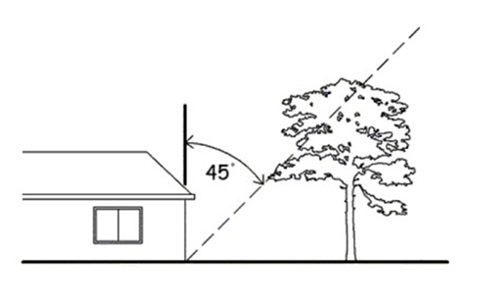The Gordon Timbs 45 Degree Rule
What is The Gordon Timbs 45 Degree Rule?
The Rule allows for the removal of a tree if it is closer than its own height to an approved building, which includes a dwelling, garage, or outbuilding. This means where any part of a tree is above a line 45 degrees from the vertical extension of the wall of any building measured from its base (as shown in Figure 1). Hollow bearing trees can only be removed without assessment under the Gordon Timbs 45 Degree Rule exemption if an animal handler is present.

For trees that can be removed without consent at any time, as identified in the Shoalhaven Development Control Plan (DCP) 2014, please view the exempt tree species list.
If the tree is at IMMINENT RISK of falling contact the State Emergency Service (SES) immediately on 132 500.
If a tree poses an imminent risk to human life or significant property, it can be immediately removed without Council approval. You should contact the NSW SES or a qualified arborist for assistance.
If the tree is heritage listed, on land that is heritage listed or in a heritage conservation area, you will need to contact Council prior to the tree being removed.
What do I do if I can't remove a tree using The Gordon Timbs 45 Degree Rule?
If the tree:
- is not within 45 degrees of an approved building (including, dwelling, garage or outbuilding)
- is located within the Jeberra Estate
- is protected as part of the conditions of a development consent
- is protected under a Section 88B Instrument under the Conveyancing Act 1919
- Is located in a heritage setting (heritage item, Aboriginal object, Aboriginal place of heritage significance, or on land within a heritage conservation area)
An application must be submitted to Council via the NSW Planning Portal for a tree permit to consider removal. Instructions on how to submit an application via the NSW Planning Portal can be found here.
The Gordon Timbs 45 Degree Rule does not apply to rurally zoned land:
- RU1 Primary Production
- RU2 Rural Landscape
- RU3 Forestry
- RU4 Primary Production Small Lots
Any request to remove or prune a tree on rural land must be directed to the NSW Local Land Services (LLS). LLS can be contacted on 1300 795 299 or visit the Local Land Services website for more information.
For further questions or concerns, please reach out to our environmental services team.
For further questions and answers on tree removal on private land, please go to the 'Frequently asked questions' section of the Trees on Private Land page.